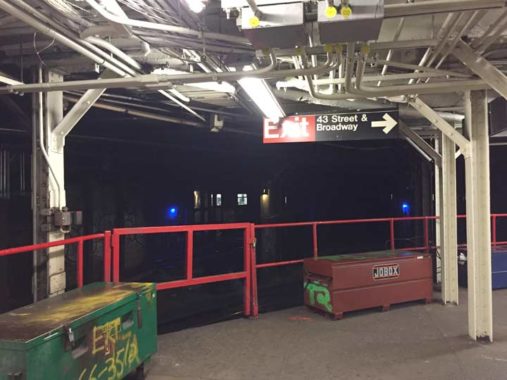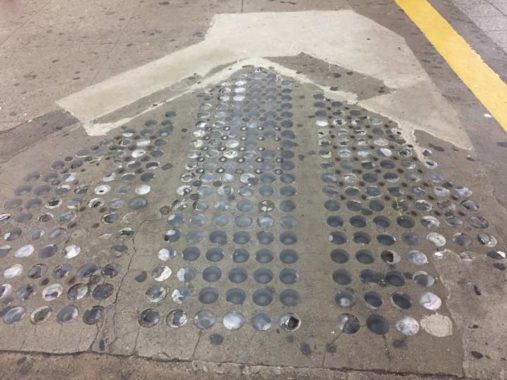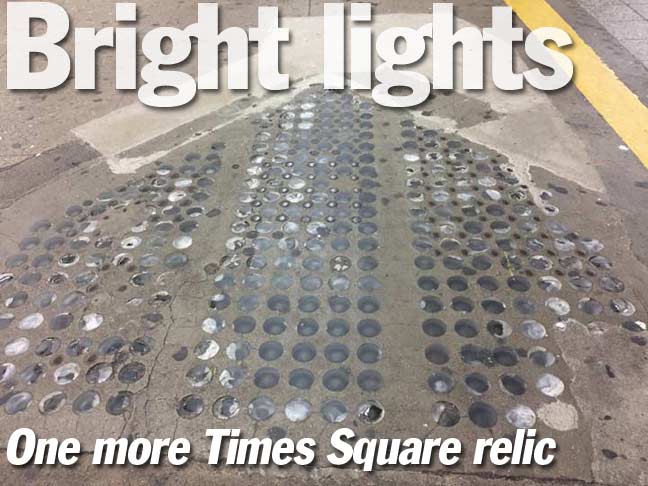Of all of New York City’s hundreds of subway stations, the Times Square Shuttle station is the one I’ve always found the most fascinating. The original IRT subway constructed from 1900-1904 was basically S or Z-shaped and ran from City Hall north on Elm (later Lafayette), 4th Avenue, Park Avenue, then west on 42nd and north again on Broadway to a terminus at 145th Street. Of course more stations and lines were built in short order from 1905-1908.
When a second impetus of building subways and elevated lines began as part of the Dual Contracts funding the IRT and BMT in the early 1910s, that “S/Z” became an H as the original IRT was run up to the Bronx via Lexington and then south to Brooklyn along 7th Avenue and Varick Street. This caused big changes at the original Times Square station, which became orphaned as a result of those uptown and downtown expansions. It became a shuttle train running between Times Square and Grand Central, with transfers to nearly a dozen other subway lines. At first these transfers were not free: they only became so after the subways were unified in 1940, with the true interconnectedness with free transfers not achieved until the late 1940s.
I worked an overnight job for the first time in over 25 years in the spring of 2018. Occasionally, I’d make my way through the Times Square Shuttle station in the early morning after work to check on its many oddities.

Today, the Shuttle is still connected to the Lexington Avenue line (#4, 5, 6) via Track One, and to the Broadway/7th Avenue line (#1, 2, 3) via Track 4, with the connection shown above. The connection is unobstructed at Grand Central, but at Times Square, a metal platform covers the active track to allow passengers to go to the Track 4 platform or exit on 43rd Street. If a connection needs to be made, the platform can be moved in a painstaking process. NYC Subway has some photographs of MTA personnel moving the platform on its shuttle page.

You can still see skylights in the Track One platform. There is a long-closed staircase and pedestrian passageway beneath the tracks that enabled passengers to get from Track 1 to Track 4. This connection was shuttered long ago. While it was electrically lit, these skylights also allowed ambient light to enter the passageway. Today, that platform crossing Track 4 is the only way for passengers to move across the Shuttle platforms.
You can still see skylights that look like this downtown in Tribeca. They allowed sunlight into the basements of some of the buildings. The skylights were made from a variety of tempered glass that in some cases has turned a purplish color from its production using the chemical element manganese.

There is no Track 2 at the Times Square Shuttle platform, or rather, not any more. As part of the station renovations that transformed the station into a shuttle, Track 2 was converted into a platform. This is obvious from the columns with diagonal struts that hold up the tunnel roofs — these are rarely seen on revenue platforms, where they usually have a more columnar design on older IRT and BMT stations. You can also see these columns on the passageway at GCT.

I’ve photographed the Knickerbocker doorway often at the east end of the Track 1 platform often. This was a direct connection from the old Knickerbocker Hotel to what was, when the platform was opened in 1904, the Times Square subway station. I doubt the operators of the hotel had enough pull to allow patrons direct access to the platform without purchasing a ticket for a nickel (turnstiles were introduced in the 1910s) so, the door must have been locked for the most part. In the summer of 2014, the New York Times did an excellent story on this mysterious passageway’s lore and legend, including a coveted glimpse of what’s behind the door.

Speaking of the Times, there’s another old doorway on the shuttle platform that gets quite a bit less publicity. Walk to the other end of the platform from the Knickerbocker door and look toward the ceiling, where you will see the faint outline of an archway.
This door led directly to the New York Times Tower (the one now covered in billboards and ringed by the famous “zipper”). The New York Times’ press room was directly below the station and the newspaper noted in 1905 that “it is possible in the early morning hours to load the successive editions on subway cars for the most rapid general distribution” although the paper would remain in the Times Tower for only 8 years.
Soon after, the entrance was bricked up, although the remains of an archway above the door are still evident.
Source: “Crossroads of the Whirl,”David Dunlap, NY Times March 28, 2004
Check out the ForgottenBook, take a look at the gift shop, and as always, “comment…as you see fit.”
4/2/19


7 comments
Great posting about the quintessential New York subway station. When the IRT 42nd St. Shuttle was created in its current form in August 1918, free transfers were allowed between it and the Lexington trains (today’s 4,5,6) at Grand Central, and to/from Broadway-7th Ave. trains at Times Square. Flushing (#7) and Astoria trains were also accessible to other IRT routes via a free transfer at either location. The BMT trains at Times Square, however, did not have free transfers to/from IRT trains, or any other stations where IRT, BMT, and later IND routes intersected each other. There was possibly a single exception – Queensboro Plaza between the IRT and BMT – but documentation about this is sketchy.
The three-step stairway in the middle of today’s Times Square mezzanine, between the IRT and BMT stations, is most likely where turnstiles were located to collect nickels from passengers transferring between the two operators.
This policy continued even after the full subway unification in June 1940 brought the subways under a common, municipal ownership and operation. I remember my late father telling me how during World War II, he was an Army code breaker stationed at Brooklyn’s Fort Hamilton and living off-base in Upper Manhattan. He took today’s #1 train to Times Square and then switched, for another nickel, to the BMT (today’s N and R lines) to go to 95th Street and 4th Avenue in Brooklyn.
On July 1, 1948, when the fare was increased from five to ten cents, free interdivisional transfers were established at Times Square and thirteen other stations where at least two of the three subway divisions (IRT, BMT, IND) intersected each other. This fact is documented in my book From a Nickel to a Token in Chapter 7, on pages 65 and 66. Additional free transfers have been added since 1948, such as the IND 8th Avenue line becoming part of the Times Square complex in 1988.
The purplish colored glass isn’t from the sunlight. Purple glass is made from the addition of the element manganese.
We have similar purple glass embedded in the sidewalks of Seattle in Pioneer square that date back to the early 1900s
We just returned from Dublin, there were skylights of thick glass in front of many old buildings ther as well. I enjoyed this article, and look forward to reading more like it.
I never knew that “Knickerbocker” door still opened, to say nothing of there being something behind it. Amazing. No matter how long you study subway mysteries, there are always more waiting to be discovered.
The purple color of the glass is due to long exposure to sunlight reacting with the manganese used as flux in manufacturing. The manganese came from Germany until 1914, when the British blockade ended imports. Substitutes were found that did not produce the purple color, so imports were restarted after the end of WW1. The purple glass can be pretty reliably dated to pre-1914.
Queensboro Plaza — There were two stations there with separate fare controls. Only the IRT station is still standing. At stations east, the same nickel gave you access to IRT or BMT trains. I don’t know how the fares were apportioned. Passengers going to the city were advised to take a BMT train if they wanted to change to the BMT subway at Queensborough Plaza. From an IRT train they would have to pay another fare.
Me and my older brother traveled into the City to see the Columbus Day Parade on Wednesday October 12, 1960. I was twelve and my brother just turned 15. This was before the enactment of the federal Monday holiday law, so when Columbus Day fell on a Wednesday we all celebrated it on that Wednesday. Everyone had the day off, including the schools. New York City was one of the nation’s cities that ran a big slam-bang parade down the middle of the city, passing, of course, Columbus Circle and its statue of Columbus.
Our travel to the parade route was simple that morning. We rode the Flushing Line, followed by the uptown IRT. We started to view the parade around Columbus Circle and eventually followed the parade southward to Times Square. After the parade we entered the shallow underground Time Square complex and headed for the Flushing subway line, which was deep underground. As we were passing the Times Square Shuttle a terrific explosion occurred. Both of us bolted for the exits, or anywhere but there. The explosion jarred 60 years of grime from the rafters, pouring black soot upon everyone. I ran for a while and finally stopped, and looked around. My brother was nowhere to be seen! Panic set in and I decided to run back from whence I had come to see if my brother was injured. I arrived back to near the bomb site next to the Times Square Shuttle, and from the other direction came running my black-faced brother looking to find me. We both had the same reaction to stop, and return back from where had bolted to find the other brother. We counted our fingers and toes and all our parts seemed to be there, so we high-tailed it out of there to find the #7 Flushing line. No more sightseeing for us that day. We both had black-smudged faces to show for our excursion that day. We sure had a doozy of a story to tell our parents when we got home. The Columbus Day bomb was located in one of those coin-operated photo booths. Fortunately, no one was using it at the time, but the explosion was next to one of the Time Square Shuttle cars, and most of the 34 injured people were showered by flying glass.
This explosion turned out to be the third of five bombs planted by the person called by the newspapers the Holiday or the Sunday Bomber. It all started on October 2 when a black-power bomb went off in Duffy Square at the north end of Times Square, followed a week later near the New York Library on Fifth Avenue and 42nd Street. A fourth bomb went off on the Staten Island Ferry. It wasn’t until he killed a girl riding on a subway near 125th street on November 7 that these types of bombs stopped. Unlike the Mad Bomber, who was caught a few years before in the earliest example of modern-day profiling science, this Sunday Bomber was never caught.